Chapter: Security in Computing : Elementary Cryptography
Transpositions (Permutations)
Transpositions (Permutations)
The goal of substitution is
confusion; the encryption method is an attempt to make it difficult for a
cryptanalyst or intruder to determine how a message and key were transformed
into ciphertext. In this section, we look at a different kind of scrambling
with the similar goal. A transposition is
an encryption in which the letters of the message are rearranged. With
transposition, the cryptography aims for diffusion, widely spreading the information from the message or the key
across the ciphertext. Transpositions try to break established patterns.
Because a transposition is a rearrangement of the symbols of a message, it is
also known as a permutation.
Columnar Transpositions
As with substitutions, we
begin this study of transpositions by examining a simple example. The columnar transposition is a
rearrangement of the characters of the plaintext into columns.
The following set of characters is a
five-column transposition. The plaintext characters are written in rows of five
and arranged one row after another, as shown here.

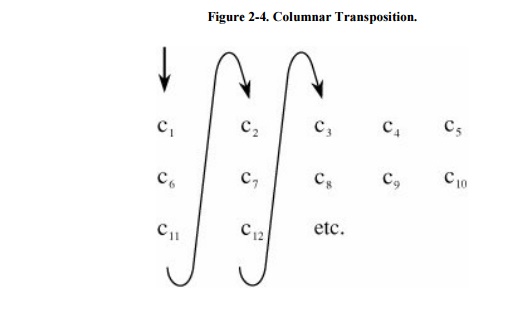
For instance, suppose you want to write the
plaintext message THIS
IS A MESSAGE TO SHOW HOW A COLUMNAR TRANSPOSITION WORKS. We arrange the letters in five columns as
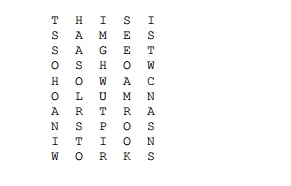
The resulting ciphertext
would then be read down the columns as
tssoh oaniw haaso lrsto imghw
utpir seeoa mrook istwc nasns
In this example, the length
of this message happens to be a multiple of five, so all columns are the same
length. However, if the message length is not a multiple of the length of a
row, the last columns will be one or more letters short. When this happens, we
sometimes use an infrequent letter, such as X, to fill in any short columns.
Encipherment/Decipherment Complexity
This cipher involves no
additional work beyond arranging the letters and reading them off again.
Therefore, the algorithm requires a constant amount of work per character, and
the time needed to apply the algorithm is proportional to the length of the
message.
However, we must also
consider the amount of space needed to record or store the ciphertext. So far,
the other ciphers we have seen require
only a constant amount of
space (admittedly up to 262 locations). But the columnar transposition algorithm requires
storage for all characters of the message, so the space required is not
constant; it depends directly on the length of the message.
Furthermore, we cannot
produce output characters until all the message's characters have been read.
This restriction occurs because all characters must be entered in the first
column before output of the second column can begin, but the first column is
not complete until all characters have been read. Thus, the delay associated
with this algorithm also depends on the length of the message, as opposed to
the constant delay we have seen in previous algorithms.
Because of the storage space
needed and the delay involved in decrypting the ciphertext, this algorithm is
not especially appropriate for long messages when time is of the essence.
Digrams, Trigrams, and Other Patterns
Just as there are characteristic letter
frequencies, there are also characteristic patterns of pairs of adjacent
letters, called digrams. Letter
pairs such as -re-, -th-, -en-, and -ed - appear very frequently. Table 2-2 lists the ten most common digrams and trigrams (groups of three letters) in
English. (They are shown in descending order of frequency.)
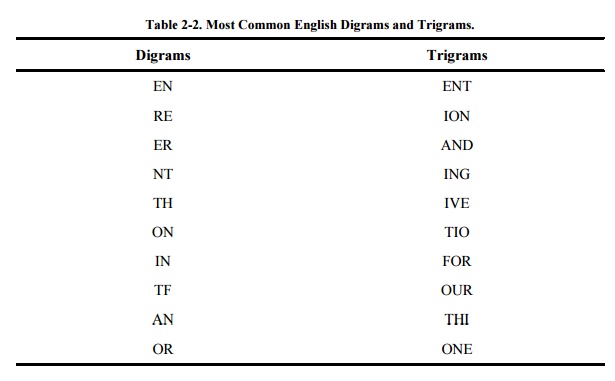
It is also useful to know
which pairs and triples do not occur often in English because that information
helps us eliminate possibilities when decrypting a message. For instance,
digram combinations such as -vk- and -qp- occur very infrequently. (The
infrequent combinations can occur in acronyms, in foreign words or names, or
across word boundaries.) The frequency of appearance of letter groups can be
used to match up plaintext letters that have been separated in a ciphertext.
Cryptanalysis by Digram Analysis
Suppose we want to decrypt a message that has
used a columnar transposition for its encryption algorithm. The basic attack on
columnar transpositions is not as precise as the attack on substitution
ciphers. Even though transpositions look less secure than substitutions, they
can in fact be more secure. Transpositions leave the plaintext letters intact,
so the work for the cryptanalyst is more exhausting; more relies on a human's
judgment of what "looks right."
The first step in analyzing the transposition
is computing the letter frequencies. If we find that in fact all letters appear
with their normal frequencies, we can infer that a transposition has been
performed. Given a string of text, the trick then is to break it into columns.
Two different strings of letters from a
transposition ciphertext can represent pairs of adjacent letters from the
plaintext. The problem is to find where in the ciphertext a pair of adjacent
columns lies and where the ends of the columns are.
We must do an exhaustive comparison of strings
of ciphertext. The process compares a block of ciphertext characters against
characters successively farther away in the ciphertext. To see how this works,
imagine a moving window that locates a block of characters for checking. Assume
the block being compared is seven characters. The first comparison is c1
to c8, c2 to c9, …, c7 to c14.
Then, we try a distance of eight characters, and so the window of comparison
shifts and c1 is compared to c9, c2 to c10,
and continuing. For a block of nine characters, the window shifts again to c1
against c10, and so forth. This process is shown in Figure 2-5.
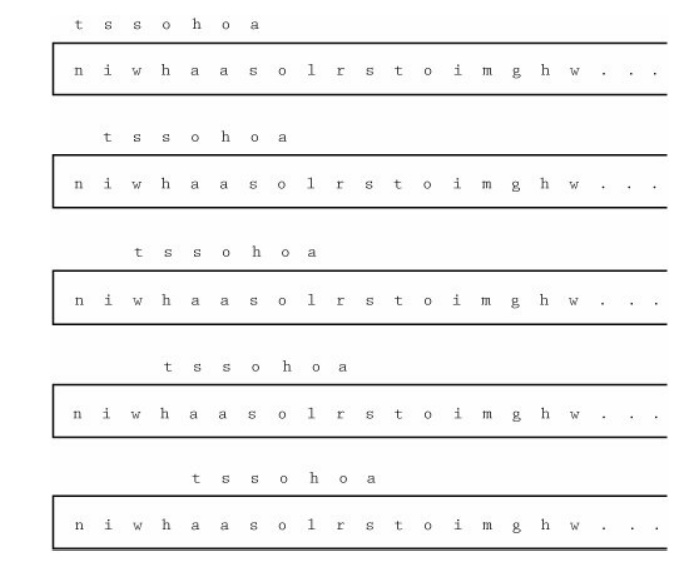
For each window position, we ask two questions.
First, do common digrams appear, and second, do most of the digrams look
reasonable? When digrams indicate a possible match for a fragment of
ciphertext, the next step is to try to extend the match. The distance between c1
and ck+1 implies that another column might begin k positions
later (because the distance is k). If ci and ci+k match,
so also should ci+k and ci+2k, etc. To test that theory,
we check ck against c2k, and so on.
Combinations of Approaches
Substitution and
transposition can be considered as building blocks for encryption. Other
techniques can be based on each of them, both of them, or a combination with
yet another approach. For instance, Sidebar 2-5
describes how substitution can be combined with a one-time pad. Keep in mind as
you read about encryption that each technique is only one piece of the larger
puzzle. Just as you could have a locked car inside a locked garage, you could
also combine various approaches to encryption to strengthen the overall
security of your system.
A combination of two ciphers is called a product cipher. Product ciphers are typically performed one after
another, as in E2(E1(P,k1), k2).
Just because you apply two ciphers does not necessarily mean the result is any
stronger than, or even as strong as, either individual cipher.
Sidebar 2-5:
Soviet Encryption During World War II
Kahn [KAH96] describes a system that
the Soviet Union thought unbreakable during World War II. It combined
substitution with a one-time pad. The basic idea was to diffuse high-frequency
letters by mapping them to single digits. This approach kept the length of
cryptograms small and thus reduced the on-air time as the message was
transmitted.
To see how
the encryption worked, consider the eight most common letters of the English
language: ASINTOER, arranged as in "a sin to er(r)" to make them easy
to remember. These letters were assigned to single digits, 0 to 7. To encode a
message, an analyst would begin by selecting a keyword that became the first
row of a matrix. Then, the remaining letters of the alphabet were listed in
rows underneath, as shown below. Moving vertically through the matrix, the
digits 0 to 7 were assigned to the eight common letters, and then the two-digit
groups from 80 to 99 were mapped to the remaining letters of the alphabet plus
any symbols. In our example, the keyword is SUNDAY:
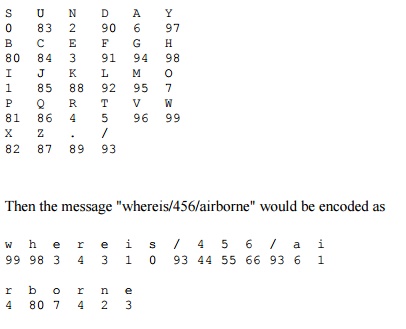
or 99983431
09344556 69361480 7423. (Digits of plaintext numbers were repeated.) Finally,
the numerical message was encrypted with a one-time pad from a common reference
book with numerical tablesone that would not arouse suspicion, such as a
navigator's book of tables.
Related Topics